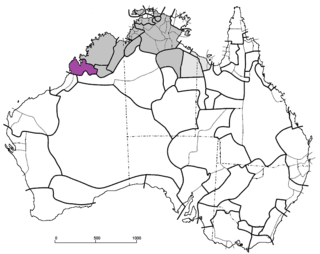This page is based on this
Wikipedia article Text is available under the
CC BY-SA 4.0 license; additional terms may apply.
Images, videos and audio are available under their respective licenses.
The Bibulman (Pibelmen) were an indigenous Australian people of the southwestern region of Western Australia
The Mandi, otherwise known as Manthi, were an indigenous Australian people of Western Australia.
The Mandara were an indigenous Australian people of the Pilbara region of Western Australia. They are extinct, having been absorbed into neighboring peoples, and their language is unrecorded.
The Wirngir are an indigenous Australian people of the Kimberley region of Western Australia.
The Yeidji, otherwise commonly known as the Gwini, are an indigenous Australian people of the Kimberley area of Western Australia.
The Unggarranggu, also traditionally transcribed as Ongkarango, are an indigenous Australian people of Western Australia.
The Wilawila are an indigenous Australian tribe of the Kimberley region of Western Australia.
The Wurla, also written Ola, or Waladjangarri, are an indigenous Australian people of the Kimberley region of Western Australia
The Kurajarra were an indigenous Australian people of Western Australia. Their existence as a people was overlooked in Norman Tindale's classic 1974 survey of Australian Aboriginal tribal groups and their language is unattested.
The Tenma or Thiin were an indigenous Australian people of Western Australia.
The Doolboong, also known as Duulngari, were an indigenous Australian people of the Northern Territory and northeast Western Australia.
The Djaberadjabera, also written Jabirrjabirr, were an indigenous Australian people of Western Australia.
The Binigura were an indigenous Australian people of the Pilbara region of Western Australia.
The Ngombal, also known as the Ngumbarl, are an indigenous Australian people of Western Australia.
The Nyulnyul are an indigenous Australian people of Western Australia.
The Inawongga were an indigenous Australian people of the Pilbara region of Western Australia.
The Kalaako (Kalarko) were an indigenous Australian people of the Goldfields-Esperance region of Western Australia.
The Malngin were an indigenous Australian people of Western Australia. The Malngin language was a dialect of Gurindj.
The Kukatj were an indigenous Australian people of the state of Queensland. They are to be distinguished from the Kukatja, either the Northern Territory Loritja or the Western Australian Gugadja.





